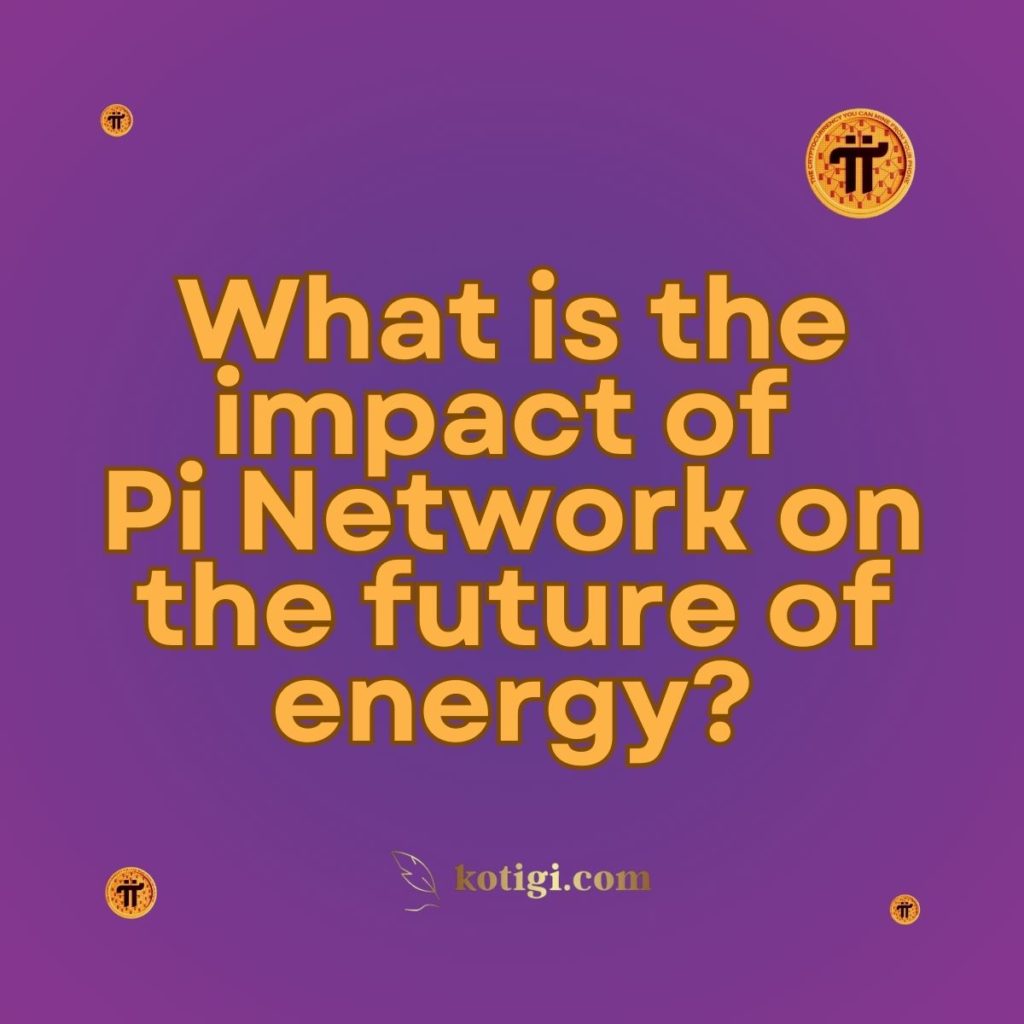
What is the impact of Pi Network on the future of energy?
Pi Network’s decentralized blockchain technology holds the potential to revolutionize the energy sector by promoting peer-to-peer energy trading, encouraging renewable energy adoption, enhancing grid efficiency, and decentralizing energy systems. This article explores the impact Pi Network could have on the future of energy.
Introduction
The energy sector is undergoing a significant transformation as the world shifts toward renewable energy sources and decentralized energy systems. Traditional energy grids, often controlled by large corporations and centralized systems, are increasingly facing challenges related to sustainability, efficiency, and accessibility. Emerging technologies like blockchain are offering solutions to these challenges by decentralizing control and enabling new ways of generating, distributing, and consuming energy. Pi Network, a mobile-based cryptocurrency, is well-positioned to drive these changes. Through its decentralized model, Pi Network can facilitate peer-to-peer energy trading, enhance energy grid management, and promote the integration of renewable energy. In this article, we’ll explore how Pi Network could impact the future of energy, helping to create a more sustainable and decentralized energy ecosystem.
Decentralized Energy Trading
Pi Network can play a pivotal role in enabling decentralized, peer-to-peer (P2P) energy trading systems, transforming how energy is bought and sold.
Peer-to-Peer Energy Exchanges
Traditional energy grids are centrally managed, with large utility companies controlling the distribution of power. Pi Network’s decentralized structure can enable P2P energy trading, where individuals can generate their own energy—through solar panels or other renewable sources—and sell the excess directly to neighbors or local businesses. Using Pi coins as a medium of exchange, these transactions can be completed without the need for a central utility provider.
Lowering Costs for Energy Consumers
By cutting out the middlemen (such as utility companies), Pi Network allows energy producers and consumers to trade energy directly, potentially reducing costs for both parties. This decentralized system ensures that energy prices are determined by local supply and demand rather than large corporate entities.
Increasing Grid Efficiency
P2P energy trading, powered by Pi Network’s decentralized blockchain, can enhance energy grid efficiency by ensuring that energy is consumed locally where it is produced. This reduces the strain on national grids, minimizes energy loss during transmission, and creates a more resilient energy system.
Promoting Renewable Energy Adoption
Pi Network’s decentralized model encourages the use of renewable energy by providing financial incentives and fostering local energy generation.
Tokenized Incentives for Renewable Energy
Pi Network can support the tokenization of renewable energy credits or rewards for individuals and businesses that generate clean energy. Users can earn Pi coins by producing energy through renewable sources such as solar or wind, which can then be traded or spent within the Pi Network ecosystem. This incentivizes more individuals to invest in renewable energy technologies and contribute to a greener energy future.
Facilitating Decentralized Energy Grids
As more people adopt renewable energy sources, Pi Network can facilitate the development of decentralized microgrids. These grids allow communities to generate and distribute energy independently of the national grid, reducing reliance on fossil fuels and creating more sustainable, self-sufficient energy systems.
Supporting Small-Scale Energy Producers
One of the challenges for small-scale renewable energy producers is the lack of access to traditional energy markets. Pi Network’s blockchain technology can empower these producers by enabling them to trade energy directly with consumers or businesses using Pi coins. This opens up new revenue streams for small-scale energy producers and promotes the broader adoption of renewable energy solutions.
Enhancing Energy Grid Management
Pi Network’s decentralized blockchain technology can enhance the efficiency and management of energy grids, helping to optimize energy production and consumption.
Real-Time Energy Tracking and Allocation
Blockchain technology, as implemented by Pi Network, allows for the real-time tracking of energy production and consumption. Energy providers and consumers can use this information to optimize energy allocation, ensuring that power is delivered where it’s needed most. This decentralized tracking can help prevent energy shortages or overproduction, leading to more efficient grid management.
Reducing Energy Loss in Transmission
Energy loss during transmission is a significant issue in traditional energy grids. Pi Network’s decentralized approach can mitigate this problem by promoting localized energy production and consumption through P2P trading. By reducing the distance energy needs to travel, transmission losses can be minimized, making the energy system more efficient.
Improving Data Transparency and Security
Blockchain’s inherent transparency ensures that all transactions and energy exchanges are recorded immutably, making it easier to audit energy usage and transactions. Pi Network can provide a secure and transparent platform for energy data, reducing the risk of fraud or manipulation and building trust among energy producers, consumers, and regulators.
Decentralizing Energy Infrastructure
Pi Network’s blockchain has the potential to decentralize the energy infrastructure, empowering individuals and communities to take control of their energy systems.
Empowering Local Energy Initiatives
By decentralizing energy systems, Pi Network allows communities to establish and manage their own energy production and distribution networks. This could involve setting up community-owned renewable energy projects or local energy cooperatives where members generate, share, and trade energy using Pi coins.
Supporting Energy Independence
Decentralized energy systems reduce dependence on large, centralized energy providers. With Pi Network, individuals and communities can generate their own renewable energy, store it locally, and trade it within their local ecosystem. This fosters energy independence, making it possible for communities to rely less on external sources of energy and more on their own sustainable production.
Increasing Resilience Against Disruptions
Decentralized energy grids, supported by Pi Network, are more resilient to disruptions such as natural disasters or cyberattacks. In a decentralized system, power generation and distribution are spread across multiple nodes, reducing the risk of a single point of failure. This enhances the overall reliability and security of energy supplies.
Encouraging Global Energy Accessibility
Pi Network can help bridge the energy gap by providing decentralized energy solutions in underserved regions, particularly in developing countries.
Expanding Access to Clean Energy
In many developing countries, access to energy remains limited, with many relying on expensive or polluting sources of power. Pi Network’s decentralized model can promote the adoption of local renewable energy projects, bringing affordable and clean energy to regions that lack traditional energy infrastructure.
Reducing Energy Poverty
By enabling individuals to generate and trade energy locally, Pi Network can help reduce energy poverty in underserved areas. Communities can use Pi coins to facilitate energy transactions, making energy more affordable and accessible to those who need it most.
Supporting Off-Grid Energy Solutions
Pi Network’s decentralized infrastructure can support off-grid energy solutions, such as solar-powered microgrids, that provide reliable power to remote areas. By using Pi coins for energy trading, off-grid systems can become more sustainable and self-sufficient, improving access to electricity in regions that are not connected to the main grid.
Conclusion
Pi Network’s impact on the future of energy is profound. From enabling decentralized energy trading and promoting renewable energy adoption to enhancing grid efficiency and expanding global energy accessibility, Pi Network has the potential to transform the energy landscape. As decentralized systems become more prevalent, the energy sector will see increased efficiency, reduced costs, and a shift toward more sustainable and resilient energy solutions. Pi Network’s blockchain technology can drive this transformation, empowering individuals, communities, and businesses to take control of their energy systems and contribute to a greener, more decentralized future.
Key Takeaways
- Decentralized Energy Trading: Pi Network enables peer-to-peer energy trading, allowing individuals to sell excess renewable energy directly to consumers without relying on centralized utilities.
- Renewable Energy Incentives: Pi Network promotes the adoption of renewable energy by offering tokenized rewards for clean energy generation and supporting decentralized microgrids.
- Enhanced Grid Efficiency: Blockchain technology can help optimize energy production and consumption, reducing energy loss during transmission and improving grid management.
- Decentralized Energy Infrastructure: Pi Network empowers local communities to develop their own energy systems, fostering energy independence and resilience.
- Global Energy Accessibility: Pi Network helps bridge the energy gap in underserved regions, expanding access to affordable and clean energy through decentralized trading and off-grid solutions.





